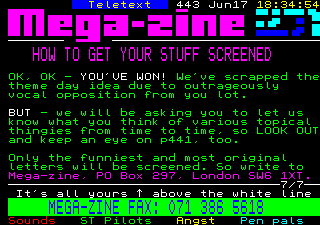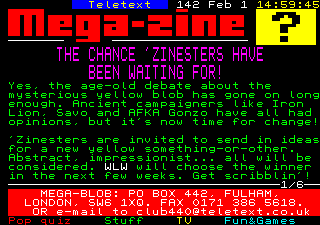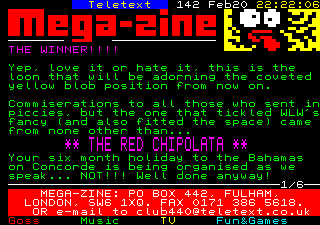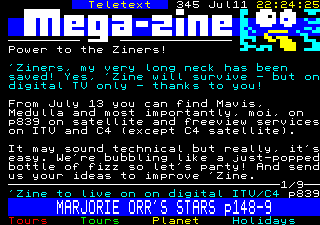The Mega-Zine Museum
History
Mega-Zine started life on the 3rd of January 1993, where it debuted alongside many other features with the launch of Teletext Ltd.'s service on Channel 4 and S4C in the UK.
Teletext is a way of broadcasting short pages of text to TV screens, accessible on demand. A wide variety of articles and low-resolution images can be viewed on a compatible set by entering the correct page number.
Just like its physical counterparts (see Wikipedia 
1993-1995: The Generator Years
The 'Zine first appeared as a part of the Generator section of Teletext. Generator was a teen magazine with a heavy focus on music, and as such Mega-Zine was the "weekend music fan mag that you write".
People wrote in with reviews of albums, singles, gigs, music videos etc. There were also a lot of lists, and many arguments over musical taste — Take That was not popular, and opinions were strongly divided about the Manic Street Preachers.
By August 1993, participation increased to the point where the 'Zine could become a daily staple.
Theme Days
In an effort to arrange the content neatly, the editors pushed the idea of "Theme Days". Every day of the week had its own topic. The themes were:
- Top Tens
- Opinions about the 'Zine
- TV Reviews
- Sport Views
- Soap Reviews
- Album, Single and TV Reviews
This idea didn't go down well, and many letters of criticism were shown. The editors eventually relented.

Amusingly, the very last edition of the 'Zine made reference to this. In response to a letter, WLW replied, "I promised more theme days. Still, what are you going to do..?"
1995-1997: The Club 440 Years
As part of an early 1995 reorganisation, the musical content was promoted into its own section. The remaining teen pages (including the 'Zine) were collated into a new feature — Club 440.
Unfortunately this reduced the amount of space available to just five pages at one point, so page one began to show short letter summaries, officially called "Short Cuts".
This also marked the beginning of the 'Zine format that would last until the end. The editor(s), under the pseudonym "WLW", would now write witty and sarcastic comments underneath many more of the contributions.
Backchat "Rivalry"
The BBC also changed their Ceefax service in 1995. The newly revamped youth magazine included a section called "Backchat", which allowed people to write in with their views on current events.
Unlike the 'Zine, letters were limited to a few short sentences per person. Also, the editors rarely commented on them, and when they did, it was all serious.
Some 'Ziners considered Backchat to be the "trendy" person's version of the 'Zine. This view wasn't taken too seriously, however, with many quietly admitting to reading Backchat in addition to the 'Zine. Nevertheless, any references to the section were typically censored to "B*ckch*t", as if it were a swear word.
1997-2003: The Club 140 Years
The Club moved to page 140, but the content was mostly the same. The 'Zine, however, began to evolve. Topics stopped being so serious and ranty, shifting towards the zany and bizarre. 'Ziners became more curious about WLW.
Topics occurring in this era include the popularity of pilchards, deciding what songs would be on a 'Zine musical album, and various conspiracy theories (all made in jest).
Teletext also began to carry more pages owing to a reduced interval between refreshes, and so eight letters were normally published a day — except on Saturdays. New letters were typically published around the same time Countdown was showing on TV, leading to plenty of comments about the show.
This combination of capacity and content may mean this was the peak era of the 'Zine.
The 'Zine Icon
When the 'Zine moved to Club, it received a new header icon to replace the generator decor. It looked something like a yellow splat of paint. Occasionally 'Ziners would try to guess what it represented, but it was probably just a random blob.
In February 1997, WLW decided to replace the icon with something new. A question mark placeholder took the blob's place, and suggestions for its replacement were welcomed.

The winning design was announced on the 20th of February 1997, created by The Red Chipolata.
It was put into use immediately. What was it? A mysterious creature bursting out of the TV, with two crossed eyes and a tongue sticking out.

The creature would become known as Davord, and was a 'Zine favourite character. Except for a minor revision to give it a sharper tongue, this design stayed with the 'Zine until the end.
2003-2006: The Ace Years
Another Teletext revamp saw the replacement of the Club with Ace, a new format of youth magazine. As such, the content began to become slightly more grounded again. Slightly.
Poetry became a lot less common, and WLW's love for Jaffa Cakes became known — a slight tweak on the love for chocolate expressed in the past.
'Zine Lore
During this period, more characters were created to accompany Davord at "WLW Towers". Some of these were:
- Mavis the Cat
- Marcel the Monkey
- Medulla the Moggy
Punchy
In 2006, WLW lost the use of the two lines beneath the white line to advertisements, so the trademark two-punch wit was replaced with a short comment above the line.
2006-2009: The Digital Years
After a close shave with the axe, a petition from 'Ziners (and presumably the persuasive tongue of WLW) managed to convince Teletext Ltd. to migrate the service to the digital channel instead.

This happened on the 13th July, 2006.
Guest Editors
Between the 10th and 31st December 2007 and again from the 10th to the 31st December 2008, WLW handed over (partial) control of the 'Zine to a guest editor each day. The guest editors were fellow 'Ziners, specially chosen by WLW for their high quality content and prominence in the community.
Editors were tasked with writing an introduction page, and witty comments in the style of WLW. The letters themselves were still assembled by WLW in advance.
The End
With massively declining readership across the whole of Teletext Ltd's non-holiday services, the axe came again for the 'Zine. Its closure was announced officially on the 24th February 2009, and the final edition aired on the 18th March 2009.
In July 2009, Teletext Ltd. announced their intention to end all non-travel content on the service, which finally happened in December.
WLW
Many sections of Teletext gave credit to their authors: Paul Goddard for music, Nick Fisher for Angst, and Paul Rose for Turner The Worm. The 'Zine did not need to do that — the authors were the viewers themselves.
When the editor(s) for the 'Zine began to comment on the letters, they needed a name. "Ed" was used at first, however WLW was quickly adopted, standing for "White Line Warrior". It referred to the space below the white line shown on almost all teletext pages where WLW would occasionally write a comment.

Ziners enjoyed getting witty remarks from WLW, but they wanted to know more. Who was he? She? It? WLW wouldn't say, and it became a running joke. The Kilted Englishman guessed that WLW was a gay giraffe, and so it became canon.
As for the truth? Nobody outside of the company knows for sure. It is quite possible that different people were behind the name over the years, Bond-style. On the other hand, the character is remarkably consistent.
The Museum thanks Insane Jam Sow for dates and interesting facts regarding the digital years.